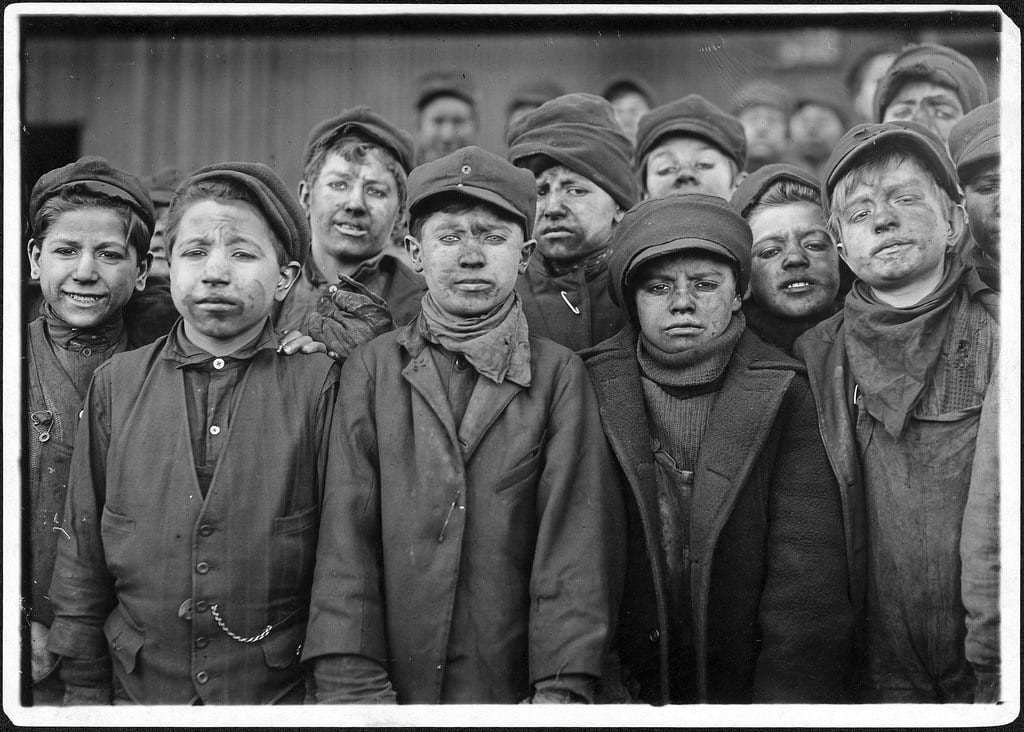
Chapter 1: Child Labor
Child labor happens in many countries. Child labor is when children are forced into hard labor, primarily when it is considered barbaric or cruel. Although child labor happens all around the world, some of the places where child labor occurs the most include Pakistan, Afghanistan, North Korea, Sudan, the Dominican Republic of the Congo, and Ethiopia. Even more so, the sub-Saharan regions in Africa have child labor. They hold the highest child labor rate of 59 million children doing labor. Of the 59 million children, 10.4% are doing hazardous work like producing tobacco (which can cause nicotine poisoning) and mining (which has toxic fumes and unstable grounds). Child labor is currently a problem in many countries and continues to affect people’s lives.
Children all around are forced into hard jobs and labor, some of which are dangerous. Agriculture is 60% of all of the child labor, and only 1 out of 5 children get paid for their hard work. (Agriculture is the practice of farming including the rearing of animals.) Other jobs include manufacturing, mining, construction, and many others. According to the International Labour Organization, “...the ILO estimates that some 22,000 children are killed at work every year." From that, it is clear evidence that much of the work that children are forced to do is dangerous. Unfortunately, eradicating child labor would outweigh costs 6 to 1, and the economy cannot handle too much money lost. Child labor is a big problem around the globe, and the steps to stop child labor are much too big. Although it will be hard to completely stop child labor, young activists are making small steps to help get rid of it altogether.
While so many people are protesting for and about the abolishment of child labor, huge improvements have not been done. Some businesses or countries have set laws on child labor, but not everyone has followed through with these sets of rules. As this is still a problem, as many people stand up for child labor in many different ways. Some activists choose to protest, make speeches, make organizations, and much more. (An activist is a person who campaigns or protests about political and social change in the world.) Influencing others to take part in what they believe is an ideal part of being an activist. Anyone can be a child labor activist as long as they are trying to make a difference. Child labor affects people all over, and while people are trying to stand up to the cause, it’s still not in perfect condition.
Chapter 2: Iqbal
Iqbal was a child forced and sold into labor at the carpet and rug industry in Pakistan. He has made an impact all over the world. He may have only been a slave to the carpet industry, but to others, he was much more. Even after his murder, he is known for his persistence and dedication as a child labor activist. He shared his tragic story to many people around the world and inspired them to help and make a difference. They realized how much of a problem that child labor is, and some of the people influenced by Iqbal are still making a difference for other children forced into labor. While Iqbal fought for the freedom of other children, he taught many people about the life within the walls of child labor and how he was treated at the factory. Even though they were only words, Iqbal influenced many around the world. He did his part, but now people have started to take action and carry his work through, and help other children and families trapped within the endless workload of child labor.
Iqbal was born in Pakistan, and at the age of 4, he was sold to the rug and carpet industry for only $12 U.S. dollars. From there, he worked as a slave until age 10 when he escaped. In the carpet industry, it was said that they “hired” the children to tie small knots to create the carpet. They chained the children to the looms, making sure that they stayed working. Even while working all day, the kids were not allowed to get up and stretch. And further, any mistakes in the carpet meant a beating and a trip to a room closely related to a torture room or chamber. As this does not make sense, they had to work in complete darkness with little to no food and water. With deprived children, their fingers remained small, this was a plus for the factory, especially when smaller fingers meant more work to be done. While many people knew the traumatic things that happen inside the factory, it took the death of a former child laborer for people to spark and start to take action for what’s really happening in the world.
After escaping the factory at age 10, Iqbal wanted to get a good education, and with persistence, he completed 6 years of school in only 2 years. He dreamed of being like Abraham Lincoln, and similarly, Iqbal wanted to free all of the children and let them go to school and get a proper education. He traveled around the world and gave speeches, visited classrooms, and many other things to share his story and influence others to help him. Some of the groups of people that met him started a campaign after his death. They raised enough money to found 8 schools around the world for children and teens affected by child labor. There are so many children under the age of 14 in child labor for the carpet industry in Pakistan. Young activists step up, but the death of one causes many questions.
Chapter 3: Helping Out
University of Iowa:
The University of Iowa is playing a big part of helping the laborers in Iowa. Within the University, the laborers in Iowa are provided with educational programs and research report. As long as they are a labor union member, people who sign up can get non-credit courses. They have helped the laborers since 1951, and still, continue to do so to this day. Many have claimed that The University of Iowa has “acted like a bridge” between Iowa’s labor community and the universities. Many laborers are being helped in Iowa because of the University of Iowa. They offer non-credit courses to help give the laborers the education or research that they want. The University of Iowa still continues to help the laborers in Iowa and has been doing so since day one is 1951.
MET:
Dora and Santos are migrant farm workers. (Migrant farm workers are people who move around with the seasons to farm.) Many of the young migrant's farm for the benefit of their family. Often, they get pulled out of school to move and follow the harvest, causing their grades to drop. But with the help of Motivation, Education, and Training (MET), they have been able to catch up on their schoolwork and homework and get help with studying, projects, and homework. As well as school help, they provide computer training and trips to area college campuses. Santos, a migrant whom has been in many different states around the U.S. (Minnesota, New Mexico, South Dakota, North Dakota, Oklahoma, California, Ohio, and Iowa), stated that MET helped get his grades of C’s and B’s up to B’s and A’s. With the help of MET, young migrant farmers can get help with school and can relieve the stress of bad grades.
Craig Kielburger:
Craig Kielburger is a very worldwide known child labor activist. As were many others, he was inspired by the young activist Iqbal. At age of only 14, he has traveled the world and made speeches to famous political figures and even just the everyday classroom. Of all of his accomplishments, Craig influenced the Canadian government, as well as testified to the U.S. congressional committee. While he stated that it took some convincing for his mother say yes to the trip across the world, he continues to be shown on television and travel all around to try and stop child labor. While he sees himself as only a volunteer, he gets calls from all over the world about what he is doing and how they can help. To become the person that he is now, he started off small and expanded his idea to his school. From there, a small group of him and his classmates worked hard and got more and more publicity. Being, as they continued to fight for children, and got more and more public, people started to catch on and want to make a difference. Craig Kielburger has influenced so many people to help take part in the abolishment of child labor and still goes on to help some more.
Chapter 4: Laws on Child Labor
In the United States, the government has pass more laws on child labor than many other countries. A lot of the laws enforce rules that countries like Africa and The Dominican Republic of the Congo do not have. They set boundaries to how much work, what kind of work, and the amount of time that they can work for children and teens. The laws are set to help prevent accidents or problems for children and their family within child labor and how much destruction it can cause. While these laws are all enforced, they are not always followed. From experience, breaking the rules can lead to accidents that most people regret. Laws are helping to dial down child labor, especially in the United States.
First off, the federal child labor provisions (child labor laws). These laws were authorized by the Fair Labor Standards Act (FLSA) of 1938 and were made to ensure the safety of which the children are doing. According to the United States Department of Labor, “By knowing, understanding, and complying with these provisions, employers, parents, and teachers can help working teens enjoy those safe, positive, early work experiences that can be so important to their development.” The federal child labor provisions are enforced to make sure that the children are not in harmful or torturous work. As they are only enforced in the United States, other countries do not follow the same rules which can cause harm and even death to the small children working.
Some of the minimum age standards for nonagricultural employment, include that at age 16, people can be employed for an infinite amount of hours in any job as long as it is not considered hazardous by the Secretary of Labor. The minimum payment for employees under the age of 20 is $4.25 per hour, only for the first 90 days of their employment in that job. Other than that, the minimum payment is $7.25. While most states follow the minimum wage, some branched off and have their own minimum wage. While most encourage the wage of $7.25, there are some exceptions where full-time students, student learners, apprentices, and workers with disabilities can be paid less than the minimum wage when certain certificates are issued by the Department of Labor. (U.S. Department of Labor)
According to the United States Department of Labor, teenagers 14-15 years of age cannot be employed under the following conditions: During school hours (unless they are provided work-study programs, work experience programs, or career exploration programs), before 7 AM and after 7 PM (Except from June 1 to Labor Day when the evening 7 PM is extended to 9 PM as long as you locally adopted daylight savings time), more than 3 hours a day (including Friday), more than 8 hours a day on non school days, more than 18 hours a week on school weeks, and more than 40 hours a week on non school weeks. The term week means the workweek accepted by the employer and given to the employee to document overtime hours.
To continue, 14-15 year olds cannot be in any occupation or labor work involving manufacturing, mining, jobs that include processing (filleting fish, cracking nuts, developing of photographs, and laundering), any hazardous job that was declared hazardous by the Secretary of Labor, machinery (e.i. Lawnmowers, golf carts, weed-trimmers, food mixers), no cooking over an open flame, public messenger service, outside window washing (working on window sills), unloading and loading goods, and dealing with apparatus. As this is only some, the laws in the United States tend to be very strict for everyone except migrant farmers. These many rules are to keep child labor away and safe for everyone.
As of today, child labor is a big problem all over the world and still continues to affect many people on the daily. While some countries are affected by child labor more than others, it is a worldwide problem that has many worried but only a few in action. Of the current 9 billion children (15 and under), 168 million are in child labor and have to constantly do backbreaking work. Child labor has continued to bring much attention to young activists and has many families around the world sending their children away to do hard labor. Saying goodbye every day, knowing that their child is possibly doing more, dangerous work than they are, is a terrible life. Many people are trying their best to stand up to the cause and help the people in need!
About the Creator
Grace Mitchell
Would love if I got gifts, but I’m not extremely desperate.... just need to save up money for life.
Love all of you guys!






Comments
There are no comments for this story
Be the first to respond and start the conversation.